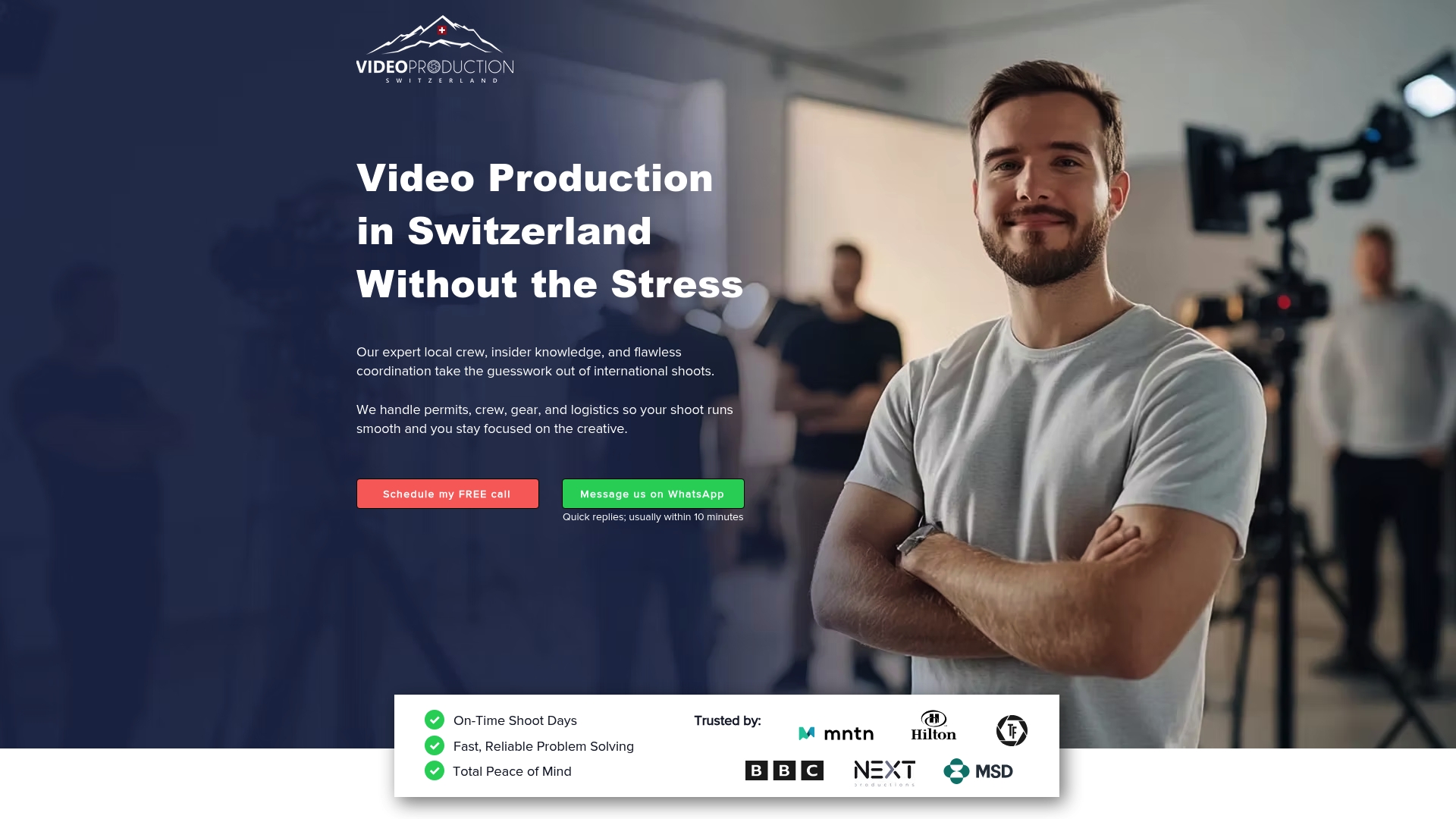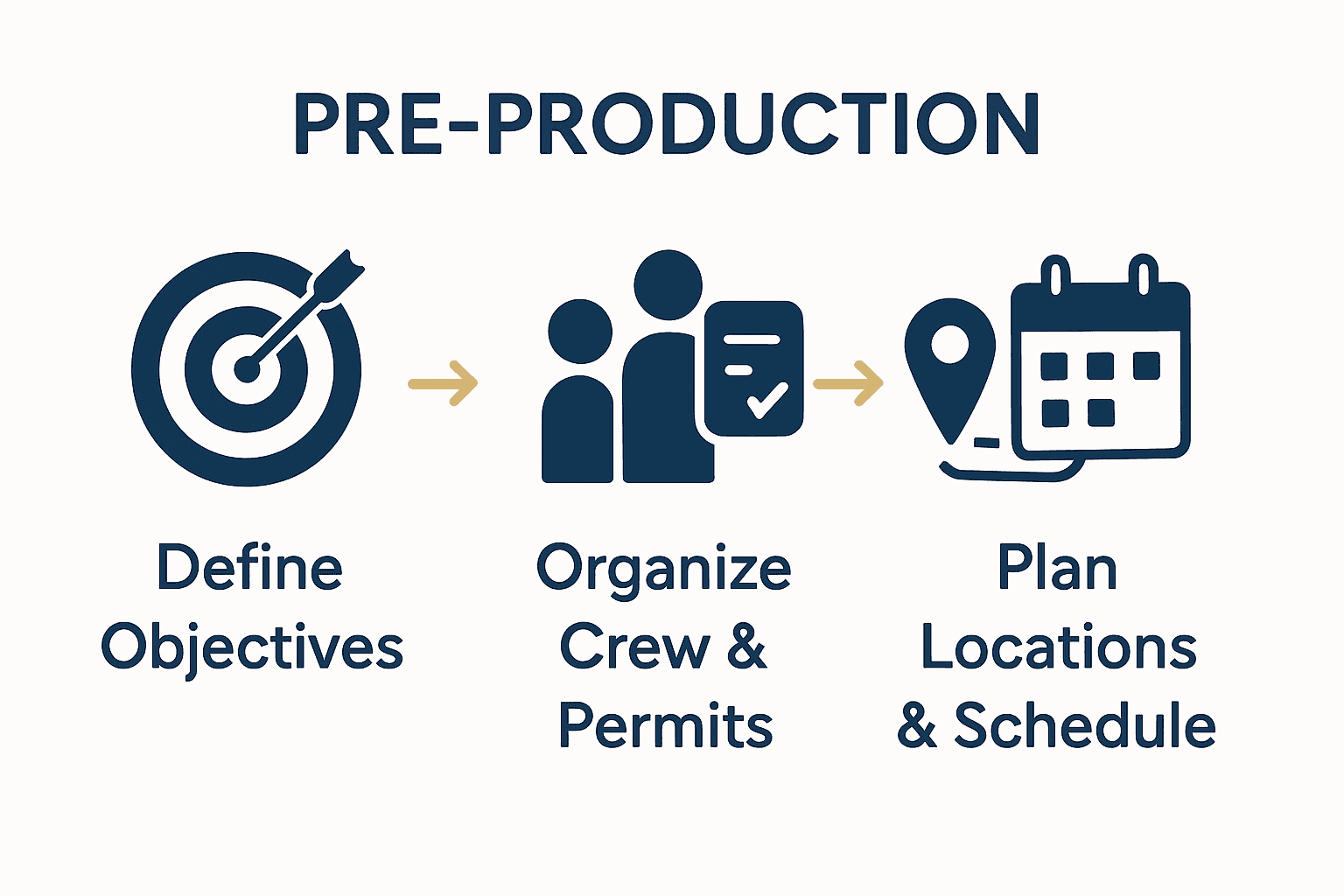Master Video Pre Production: Streamline Your Filmmaking Process
- info1419758
- 6 hours ago
- 7 min read

Video projects often go off track before the first scene is filmed. Research shows that teams who plan thoroughly in pre production are far more likely to meet their creative and financial goals. Each detail, from defining objectives to verifying crew readiness, shapes the outcome. When you master these crucial early steps, you lay the groundwork for a smooth shoot, prevent costly delays, and boost your chances of producing content that stands out.
Table of Contents
Quick Summary
Key Insight | Explanation |
1. Define clear objectives | Establish what story you want to tell and who your target audience is to guide your content creation effectively. |
2. Organize your production team | Assemble a core crew with complementary skills tailored to your project’s needs to ensure efficient collaboration. |
3. Conduct thorough location scouting | Evaluate potential filming locations for visual appeal and logistical suitability, ensuring all legal permissions are secured. |
4. Develop a detailed production schedule | Create a master schedule considering cast availability and location logistics to maintain organization throughout production. |
5. Verify pre-production readiness | Conduct a final review of equipment, permits, and team readiness to ensure a smooth transition into active production. |
Step 1: Define objectives and target audience
Before diving into video production, you need a crystal clear roadmap of what you want to achieve. According to research from Eric.ed.gov, filmmakers must crystallize their core concept and identify their intended viewers during pre-production.
Defining your objectives starts with asking yourself fundamental questions. What story are you telling? What message do you want to communicate? Who will most benefit from or connect with your content? As Wikipedia explains, understanding your target audience involves identifying specific consumer groups within a broader market to tailor your message effectively.
To pinpoint your audience, create a detailed persona that represents your ideal viewer. Consider demographics like age, gender, interests, professional background, and media consumption habits. This isn’t just about statistics it is about understanding their motivations, challenges, and emotional triggers. The more precisely you can define who will watch your video, the more powerfully you can craft content that resonates with them.
Pro Tip: Always validate your audience assumptions through market research or focus group feedback before investing significant production resources.
Once you have defined your objectives and target audience, you are ready to move into the next critical stage of pre production planning. Your clear vision will guide every subsequent creative and logistical decision.
Step 2: Organize crew, permits, and equipment
In this critical phase of pre-production, you will transform your creative vision into a logistically sound plan. According to research from Sae.edu.za, a production manager’s key responsibilities include managing budgets, securing necessary permits, and organizing essential equipment for a successful shoot.
Begin by building your core team strategically. Identify the key roles you need based on your project’s specific requirements. Pico.pens.ac.id highlights that a production coordinator must focus on setting up the production office, coordinating travel and work permits, and preparing comprehensive crew lists. Prioritize professionals with complementary skills who can collaborate efficiently.
For equipment and permits, start early and be thorough. Create a detailed inventory of every piece of gear you will need, cross-referencing with your shooting requirements. Contact local authorities well in advance to secure filming permits, understanding that processing times can vary significantly between locations. Document every permit requirement meticulously to avoid last-minute complications.
Pro Tip: Always have digital and physical backups of all permit documentation and create redundant equipment lists to prevent potential production delays.
With your crew assembled, equipment inventoried, and permits in process, you are now ready to move into the next phase of detailed production planning.

Each step you take now builds the foundation for a smooth, professional shoot.
Step 3: Scout and secure ideal locations
Location scouting is the critical bridge between your creative vision and practical production requirements. According to Wikipedia, this process involves searching for suitable places outside the studio that precisely match your script’s requirements while considering key factors like aesthetics, logistics, and legal permissions.
Begin your location scouting strategically by creating a comprehensive checklist of your scene requirements. Map out each location’s technical needs such as power sources, sound conditions, and spatial dimensions. Cinema.sfsu.edu emphasizes the absolute necessity of obtaining liability insurance and proper permits for location shooting. This means meticulously documenting every potential risk and ensuring all legal and safety requirements are thoroughly addressed before committing to a specific site.
Develop relationships with local property managers, municipal offices, and location representatives. Take high quality photographs and detailed notes during your scout. Evaluate each potential location not just for its visual appeal but for practical considerations like accessibility for your crew, parking availability, proximity to support services, and potential noise or lighting challenges.
Pro Tip: Always have backup location options and secure written permissions well in advance of your shooting date.
With your locations carefully selected and permissions secured, you are now prepared to move into the next phase of detailed production planning. Your thorough location scouting will provide the essential visual and logistical foundation for your entire production.
Step 4: Plan logistics and scheduling
Logistics and scheduling are the critical infrastructure that transform your creative vision into a realistic production plan. According to Wikipedia, creating an effective shooting schedule involves using a production board with color-coded strips representing each scene, which can be strategically rearranged to accommodate cast and crew availability and location logistics.
Start by breaking down your script into granular shooting segments. Categorize scenes by location, cast requirements, technical complexity, and potential interdependencies. This granular approach allows you to optimize your shooting sequence for maximum efficiency. Consider factors like travel time between locations, actor availability, equipment setup requirements, and potential weather constraints. Wikipedia highlights the importance of maintaining detailed daily production reports to track progress and expenses, which will help you stay on top of your logistical planning.
Create a comprehensive master schedule that includes buffer time for unexpected challenges. Communicate this schedule transparently with your entire production team, ensuring everyone understands their roles, timelines, and potential contingencies. Build flexibility into your plan while maintaining a structured approach that keeps the production moving forward smoothly.
Pro Tip: Always create multiple scheduling scenarios to account for potential disruptions, and maintain open communication channels with all key team members.
With your logistics and scheduling meticulously planned, you are now ready to move into the detailed execution phase of your production. Your strategic approach will help minimize unexpected challenges and keep your project running like a well-oiled machine.
Step 5: Verify pre production readiness
As you approach the final stages of pre production, a comprehensive verification process becomes critical to ensure your project launches smoothly. According to Cinema.sfsu.edu, verifying pre production readiness requires meticulously confirming that all equipment is accounted for, insurance policies are solidly in place, and all necessary permits and agreements are securely obtained.
Conduct a systematic final review across multiple dimensions of your production. Start with a comprehensive equipment audit, checking each piece of gear against your original requirements. Verify technical specifications, confirm rental or ownership documentation, and ensure all equipment is in optimal working condition. Cross reference your insurance coverage to guarantee complete protection for your crew, equipment, and potential location risks. Simultaneously, perform a final documentation review to confirm all permits, location agreements, and legal clearances are current and properly filed.
Schedule a final pre production meeting with your core team to walk through every critical detail. This is your opportunity to address any lingering questions, confirm individual responsibilities, and ensure everyone understands the production strategy. Encourage open communication and create space for team members to raise potential concerns or offer last minute insights that could enhance your production planning.
Pro Tip: Create a comprehensive pre production verification checklist that covers equipment, legal documentation, team readiness, and logistical preparations to serve as your final quality control mechanism.
With your pre production thoroughly verified and confirmed, you are now prepared to transition into active production. Your meticulous preparation will serve as the foundation for a smooth and successful shoot.
Simplify Your Video Pre Production with Expert Local Support
Mastering video pre production means tackling complex challenges like securing filming permits, organizing reliable crew and equipment, and scouting perfect locations. These essential steps demand precision and local knowledge to avoid last minute setbacks and costly delays. If coordinating all these moving parts feels overwhelming your goal is to create clear logistics and scheduling that enable a stress-free shoot.
At Video Production Switzerland we specialize in providing trusted local expertise that streamlines your entire pre production process. With over 20 years of experience we handle everything from permit acquisition and crew sourcing to detailed equipment management and location logistics. Our client centered approach guarantees smooth on-time productions so you can focus on your creative vision.
Ready to take the uncertainty out of your next shoot and ensure flawless execution?

Discover how our comprehensive services can make your pre production planning effortless. Visit Video Production Switzerland for a free consultation and detailed needs assessment. Start your journey to seamless filmmaking today.
Frequently Asked Questions
What are the key steps in the pre-production process for video filmmaking?
Start with defining your objectives and target audience, then organize your crew, secure permits, and inventory equipment. Follow with location scouting, logistics planning, and a final verification check to ensure everything is ready before filming begins.

How can I effectively define my target audience for a video project?
To define your target audience, create a detailed persona that includes demographics, interests, and media habits. Consider their motivations and challenges to tailor your content effectively, ensuring it resonates with viewers.
What should I include in my equipment inventory for video production?
Your equipment inventory should list all necessary gear, including cameras, lighting, and sound equipment, along with any rental agreements. This thorough checklist helps prevent last-minute surprises and ensures all essential items are accounted for before the shoot.
How do I create a shooting schedule for my video production?
Break down your script into manageable segments and categorize scenes by location and cast requirements. Build a comprehensive shooting schedule that accounts for travel time, actor availability, and buffer periods to handle unexpected challenges.
What steps should I take to verify pre-production readiness?
Conduct a thorough review of your equipment, insurance, and all necessary permits to ensure nothing is overlooked. Hold a final pre-production meeting with your team to confirm responsibilities and address any last-minute concerns, ensuring readiness for the shoot.
How can I enhance my location scouting process for a video shoot?
Create a checklist focused on your scene requirements and evaluate each location for aesthetics, logistics, and accessibility. Establish relationships with property managers and local offices for smoother permissions and always have backup options available.
Recommended

Comments